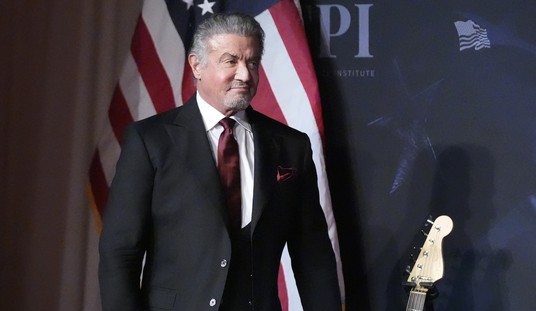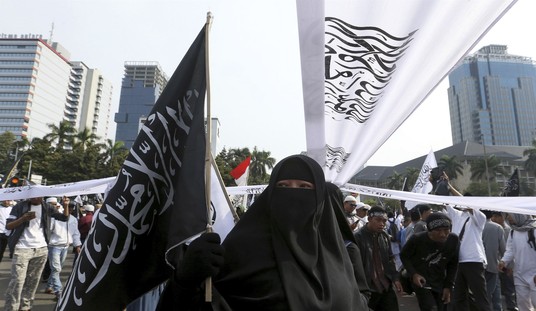There’s a famous picture from the Liberian civil war showing a militiaman geared up with “body armor”. The militiaman’s body armor is actually a flotation device or life jacket. But it sort of looks like body armor and he may think it’s going to work. It may give him some psychological protection, but the life jacket is of doubtful ballistic worth.
The proof of any defensive system is whether it actually works. In the case of body armor, it is whether the gear stops projectiles of a certain type. In the case of defenses against disease, the test is whether it detects and hinders disease carriers. The protective screen between the West African Ebola outbreak did not stop a Liberian man from flying to Texas. This has prompted a bipartisan group of lawmakers to inquire into the adequacy of America’s epidemiological body armor.
After a Liberian man arrived in Dallas and became the first confirmed Ebola case in the U.S., lawmakers are urging more aggressive action and some said they would convene hearings. Ohio Republican Senator Rob Portman renewed a call for the U.S. to check travelers for Ebola symptoms, pressing Thomas Frieden, head of the Centers for Disease Control and Prevention….
In a letter yesterday, congressional Democrats led by California’s Henry Waxman, said lawmakers should hold a hearing to examine, among other things, whether U.S. officials are “adequately screening travelers to and from Africa to prevent importation of additional cases into the United States.”
Jason McDonald, a spokesman at the CDC, said the agency has no intention of raising screening process at U.S. airports from passive to active.
Does it really work, or is it like the Liberian militiaman’s armor, more reassuring than real? The reason the CDC retains confidence in its defenses is because it regards the arrival of Thomas Eric Duncan an example of a ‘freak shot’. He transited the defensive belt in the time gap before he became symptomatic, which to the CDC’s way of thinking is before he became contagious. Abby Phillip of the Washington Post describes the CDC’s reasoning.
While other countries have simply taken themselves insofar as possible, out of the line of fire, the CDC has opted to engage the disease for very good reasons: to monitor its genetic mutation, to stop it with a forward defense and for humanitarian considerations. Now “several African nations have restricted or banned air travel from Ebola-stricken countries … Others airlines have greatly reduced air travel in the region.” But cutting off links with West Africa also prevents America from taking Ebola on and if you can’t take fire, you can’t return fire.
Phillip says that instead of hiding America in a hole, the CDC put its faith in screening. Travel bans are “not an optimal measure for controlling the import of Ebola virus disease,” said chief United Nations spokesperson Stephane Dujarric. … The U.S. has similarly spurned travel restrictions.”
The screening procedures at the airport in Monrovia, the Liberian capital, have been in place for months, Deborah R. Malac, the U.S. ambassador to Liberia, told The Post in a telephone interview Thursday. The CDC’s Division of Global Migration and Quarantine has worked with airport officials on screening protocols, and, Malac said, CDC officials “have confidence that everything that was supposed to have been done was done.” …
Despite the fact that an infected passenger flew from Liberia to Dallas this month, that passenger, Duncan, was not sick — and was therefore not contagious — while he was traveling. And once people become symptomatic, they become very sick, very quickly.
In this case, it is unlikely that a sick person could go 10 days without seeking medical care, CDC Director Tom Frieden said on Tuesday.
“At this point, there is zero risk of transmission on the flight,” Frieden said. “The illness of Ebola would not have gone on for 10 days before diagnosis. He was checked for fever before getting on the flight, and there’s no reason to think that anyone on the flight that he was on would be at risk.”
The problem with Frieden’s argument is that the system in question actually failed, and failed for the simplest of reasons: the patient failed to declare his exposure in a form as required by Liberian law. The country’s president is mortified, because it is the second high profile incident of failure, the first being patient Patrick Sawyer’s ill-fated flight to Lagos, Nigeria, which caused an outbreak in that country.
The Liberian government said on Thursday that it planned to prosecute Mr Duncan over the lies while the country’s President Ellen Johnson Sirleaf told CBC today that she was ‘very angry’ that Mr Duncan had left Liberia after being exposed to Ebola and that his actions were ‘unpardonable’.
President Sirleaf also said that she hoped that no one else would contract the potentially deadly virus which has ravaged her country.
Still, the CDC never claimed that its defensive net could stop all incoming. The CDC’s argument is that it’s optimized the costs and benefits of airline screening against the need to maintain airlinks for logistical purposes with those countries. America could reduce the vector to zero or near zero by barring people originating from those areas, but that would also hinder the movement of medical personnel. And in the CDC’s judgment, that would not be a trade-off worth making.
Fair enough. After all, to use the body armor metaphor, you could make a ceramic insert so thick it will stop a 20 mm shell, but it would probably make the infantryman immobile as a man wearing a reinforced concrete slab. Compromises are necessary. But cost benefit an empirical question, not a deduction from Euclidian truth. It’s hard to say “we have confidence in a system” which has just actually failed. If it keeps failing then the issue must be revisited.
This does not however, address an inherent design flaw, which I will call the “delayed detonation” threat. Thomas Eric Duncan might well have been harmless while he was transiting the CDC’s external armor belt. But once inside the belt, the virus continued to multiply in his body and then it exploded into contagiousness. Unfortunately, the Texas hospital which he attended did not contain the blast. They sent him home and only belatedly realized what a bomb they had on their hands.
Here the body armor metaphor fails and the battleship armor paradigm more closely applies. Those great warships had two kinds of armor. External and internal. Apart from the great slabs of steel that hung from their sides, these metal leviathans were subdivided into hardened spaces, in a way designed to limit the damage of a delayed action shell within it.
Even if we grant that the CDC’s external armor belt performed to spec, the country’s internal armoring failed utterly. In this respect, the United States is probably more vulnerable than Liberia. America is the land of the jet airplane, train, automobile and extensive road network. It is the country of the giant shopping mall, the multiplex theater and the football stadium. It’s internally un-armored. Once you’re past the outer armor belt, you can run pell-mell through the country.
By contrast travel in impoverished Liberia is much slower, in many cases only by resort to foot, moving at Roman Empire speeds. There are no food stops thronged with diners dotted along the highway because there are no highways. But this hinders the virus as much as men and Liberia’s very backwardness becomes a bar to the movement of the disease. Liberia is internally subdivided by its own lack of infrastructure.
Whatever the CDC says about the fitness of its plans, this one got through. That can’t be denied. They can’t possibly count this as a ‘success’. Any more such successes and the public will start to lose confidence in their model. Nobody can expect body armor to stop all bullets. But it has to work well enough to prove its worth. The designers of defensive systems work under the disadvantage of the unknown threat. The architects of the battleship Yamato girded it with a belt they believed would resist any American capital ship shell.
And yet …
After the war the US Navy retrieved slabs of Yamato’s turret armor from spares. It was the thickest in the world. Then they fired a superheavy armor piercing shell of the kind found on Iowa class battleships at it. It was the shell Yamato would have faced in combat. The result is below. Which only goes to show you never know until you find out.
Recently purchased by readers:
The Caretaker, season 8 of Dr. Who
Midlife and the Great Unknown, audio CD, poetry
Night Soldiers, Alan Furst’s novel of secret service action on the eve of World War 2
Logitech Wireless Combo MK270 with Keyboard and Mouse
Killing Patton, The Strange Death of World War II’s Most Audacious General
Recommended:
Mathematics and the Real World, the talent needed to cope with logical mathematics gave the human race as a whole no evolutionary advantage. With this in mind, he offers ways to overcome these innate impediments in the teaching of math.
The Troop, Cut off from the mainland, the scouts of Troop 52 face a nightmare far worse than anything they could have made up around a campfire. To survive they will have to fight their fears, the elements… and eventually each other.
The Martian, an astronaut on Mars is incommunicado with earth, with air for 31 days and running out. How does he survive?
Fire HDX 8.9 Tablet, Amazon tablet
Casio fx-300MS Scientific Calculator, 240 functions
Red Gold, Alan Furst’s novel about Stalin’s French agents ordered into underground war against the Gestapo, where duplicity and treachery reign.
Did you know that you can purchase some of these books and pamphlets by Richard Fernandez and share them with you friends? They will receive a link in their email and it will automatically give them access to a Kindle reader on their smartphone, computer or even as a web-readable document.
The War of the Words for $3.99, Understanding the crisis of the early 21st century in terms of information corruption in the financial, security and political spheres
Rebranding Christianity for $3.99, or why the truth shall make you free
The Three Conjectures at Amazon Kindle for $1.99, reflections on terrorism and the nuclear age
Storming the Castle at Amazon Kindle for $3.99, why government should get small
No Way In at Amazon Kindle $8.95, print $9.99. Fiction. A flight into peril, flashbacks to underground action.
Storm Over the South China Sea $0.99, how China is restarting history in the Pacific
Tip Jar or Subscribe or Unsubscribe to the Belmont Club












Join the conversation as a VIP Member